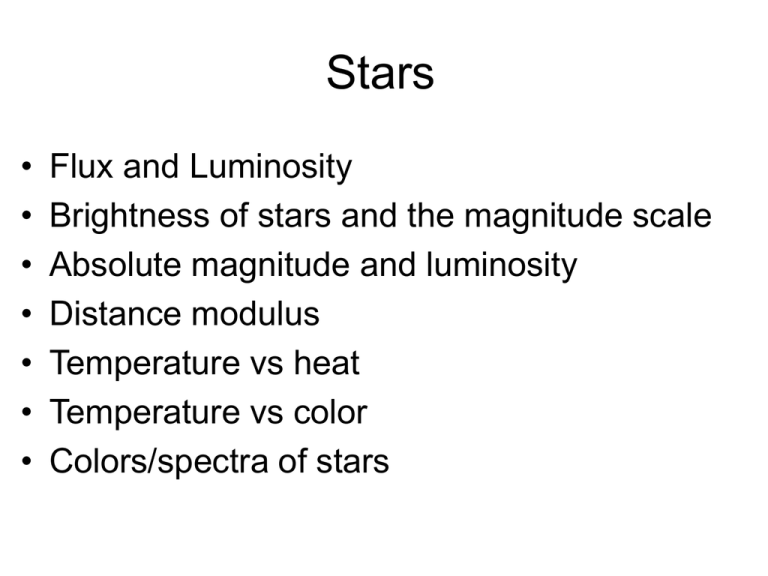Stars: flux, luminosity, color, and temperature
advertisement

Stars • • • • • • • Flux and Luminosity Brightness of stars and the magnitude scale Absolute magnitude and luminosity Distance modulus Temperature vs heat Temperature vs color Colors/spectra of stars Flux and luminosity • Luminosity - A star produces light – the total amount of energy that a star puts out as light each second is called its Luminosity. • Flux - If we have a light detector (eye, camera, telescope) we can measure the light produced by the star – the total amount of energy intercepted by the detector divided by the area of the detector is called the Flux. Flux and luminosity • To find the luminosity, we take a shell which completely encloses the star and measure all the light passing through the shell • To find the flux, we take our detector at some particular distance from the star and measure the light passing only through the detector. How bright a star looks to us is determined by its flux, not its luminosity. Brightness = Flux. Flux and luminosity • Flux decreases as we get farther from the star – like 1/distance2 L F 2 4D Brightness of stars • The brightness of a star is a measure of its flux. • Ptolemy (150 A.D.) grouped stars into 6 `magnitude’ groups according to how bright they looked to his eye. • Herschel (1800s) first measured the brightness of stars quantitatively and matched his measurements onto Ptolemy’s magnitude groups and assigned a number for the magnitude of each star. Brightness of stars • In Herschel’s system, if a star is 1/100 as bright as another then the dimmer star has a magnitude 5 higher than the brighter one. • Note that dimmer objects have higher magnitudes Little Dipper (Ursa Minor) Guide to naked-eye magnitudes Apparent Magnitude Consider two stars, 1 and 2, with apparent magnitudes m1 and m2 and fluxes F1 and F2. The relation between apparent magnitude and flux is: F1 m1 m2 2.5 log10 F2 F1 m2 m1 / 2.5 10 F2 For m2 - m1 = 5, F1/F2 = 100. Flux, luminosity, and magnitude L F 2 4D F1 m2 m1 2.5 log10 F2 L1 4D22 m2 m1 2.5 log10 2 4D1 L2 L2 D2 m2 m1 2.5 log10 5 log10 L1 D1 Distance-Luminosity relation: Which star appears brighter to the observer? Star 1 10L L Star 2 d 10d Flux and luminosity L2 10 L1 D2 10 D1 2 F2 L2 4D L2 D1 1 10 0 . 1 2 F1 4D2 L1 L1 D2 10 2 1 2 Star 2 is dimmer and has a higher magnitude. Flux and luminosity L2 10 L1 D2 10 D1 L2 D2 m2 m1 2.5 log10 5 log10 L1 D1 m2 m1 2.5 log10 10 5 log10 10 m2 m1 2.5 5 2.5 Star 2 is dimmer and has a higher magnitude. Absolute magnitude • The magnitude of a star gives it brightness or flux when observed from Earth. • To talk about the properties of star, independent of how far they happen to be from Earth, we use “absolute magnitude”. • Absolute magnitude is the magnitude that a star would have viewed from a distance of 10 parsecs. • Absolute magnitude is directly related to the luminosity of the star. Absolute Magnitude and Luminosity The absolute magnitude of the Sun is M = 4.83. The luminosity of the Sun is L = 3.861026 W. 4.83 M / 2.5 L L 10 L M 4.83 2.5 log10 L Note the M includes only light in the visible band, so this is accurate only for stars with the same spectrum as the Sun. Absolute Magnitude Absolute magnitude, M, is defined as M m 5 log10 D 5 where D is the distance to the star measured in parsecs. For a star at D = 10 parsecs, 5log10 = 5, so M = m. If we can figure out the absolute magnitude of a star, then we can determine its distance using the apparent magnitude. The “distance modulus is defined as m M 5 log10 ( D / 10 pc) Is Sirius brighter or fainter than Spica: (a) as observed from Earth [apparent magnitude] (b) Intrinsically [luminosity]? Sun Which star would have the highest magnitude? 1. 2. 3. 4. Star A - 10 pc away, 1 solar luminosity Star B - 30 pc away, 3 solar luminosities Star C - 5 pc away, 0.5 solar luminosities Star D - Jennifer Lawrence Stars: Temperature and Color • Temperature vs heat • Temperature vs color • Colors/spectra of stars Temperature lower T higher T • Temperature is proportional to the average kinetic energy per molecule 1 2 3 K mv kT 2 2 k = Boltzmann constant = 1.3810-23 J/K = 8.6210-5 eV/K Temperature vs. Heat lower T higher T • Temperature is proportional to the average kinetic energy per molecule • Heat (thermal energy) is proportional to the total kinetic energy in box less heat same T more heat Wien’s law • Cooler objects produce radiation which peaks at lower energies = longer wavelengths = redder colors. • Hotter objects produce radiation which peaks at higher energies = shorter wavelengths = bluer colors. • Wavelength of peak radiation: Wien Law max = 2.9 x 106 / T(K) [nm] A object’s color depends on its surface temperature • Wavelength of peak radiation: Wien Law max = 2.9 x 106 / T(K) [nm] What can we learn from a star’s color? The color indicates the temperature of the surface of the star. Observationally, we measure colors by comparing the brightness of the star in two (or more) wavelength bands. U B V This is the same way your eye determines color, but the bands are different. Use UVRI filters to determine apparent magnitude at each color The ratio of fluxes in two bands translates to the difference in magnitudes, or a color, e.g. B – V = mB – mV. Stellar temperature follow an approximate, empirical relation: T ~ 9000 K/[(B-V) + 0.93] The spectrum of a star is primarily determined by 1. 2. 3. 4. The temperature of the star’s surface The star’s distance from Earth The density of the star’s core The luminosity of the star Stars are assigned a `spectral type’ based on their spectra • The spectral classification essentially sorts stars according to their surface temperature. • The spectral classification can also use spectral lines. Spectral type • Sequence is: O B A F G K M • O type is hottest (~25,000K), M type is coolest (~2500K) • Star Colors: O blue to M red • Sequence subdivided by attaching one numerical digit, for example: F0, F1, F2, F3 … F9 where F1 is hotter than F3 . Sequence is O … O9, B0, B1, …, B9, A0, A1, … A9, F0, … • Useful mnemonics to remember OBAFGKM: – Our Best Astronomers Feel Good Knowing More – Oh Boy, An F Grade Kills Me – (Traditional) Oh, Be a Fine Girl (or Guy), Kiss Me Question • Which is cooler, a star with spectral type G2 or a star with spectral type A6? Classifying stars • We now have two properties of stars that we can measure: – Luminosity – Color/surface temperature • Using these two characteristics has proved extraordinarily effective in understanding the properties of stars – the Hertzsprung-Russell (HR) diagram HR diagram Absolute Bolometric Magnitude and Luminosity The bolometric magnitude includes radiation at all wavelengths. The absolute bolometric magnitude of the Sun is Mbol = +4.74. M bol L 4.74 2.5 log10 L Bolometric Correction It is difficult to measure the radiation from a star at all wavelengths. However, if one knows the temperature and the magnitude in one band, then one can integrate the blackbody spectrum over all wavelengths. We typically estimate the bolometric magnitude using the V-band magnitude and a color to estimate the temperature. “Bolometric correction” = BC = Mbol - MV.







